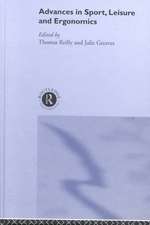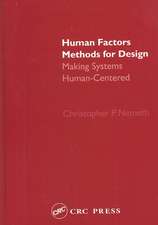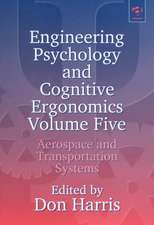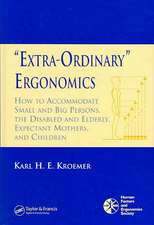Fundamental Issues in Defense Training and Simulation: Human Factors in Defence
Autor George Galanis Editat de Christopher Best Autor Robert Sottilareen Limba Engleză Hardback – 28 iul 2013
| Toate formatele și edițiile | Preț | Express |
|---|---|---|
| Paperback (1) | 429.62 lei 6-8 săpt. | |
| CRC Press – 16 apr 2017 | 429.62 lei 6-8 săpt. | |
| Hardback (1) | 1120.23 lei 6-8 săpt. | |
| CRC Press – 28 iul 2013 | 1120.23 lei 6-8 săpt. |
Din seria Human Factors in Defence
- 18%
 Preț: 1114.08 lei
Preț: 1114.08 lei - 8%
 Preț: 383.57 lei
Preț: 383.57 lei -
 Preț: 487.75 lei
Preț: 487.75 lei -
 Preț: 487.02 lei
Preț: 487.02 lei - 22%
 Preț: 324.16 lei
Preț: 324.16 lei - 15%
 Preț: 427.16 lei
Preț: 427.16 lei - 25%
 Preț: 340.62 lei
Preț: 340.62 lei - 15%
 Preț: 427.16 lei
Preț: 427.16 lei - 18%
 Preț: 1115.51 lei
Preț: 1115.51 lei -
 Preț: 489.00 lei
Preț: 489.00 lei - 15%
 Preț: 461.03 lei
Preț: 461.03 lei - 15%
 Preț: 568.28 lei
Preț: 568.28 lei - 18%
 Preț: 1108.56 lei
Preț: 1108.56 lei - 15%
 Preț: 422.76 lei
Preț: 422.76 lei - 15%
 Preț: 429.62 lei
Preț: 429.62 lei - 15%
 Preț: 427.16 lei
Preț: 427.16 lei - 26%
 Preț: 456.63 lei
Preț: 456.63 lei -
 Preț: 487.19 lei
Preț: 487.19 lei
Preț: 1120.23 lei
Preț vechi: 1366.14 lei
-18% Nou
Puncte Express: 1680
Preț estimativ în valută:
214.38€ • 232.79$ • 180.08£
214.38€ • 232.79$ • 180.08£
Carte tipărită la comandă
Livrare economică 22 aprilie-06 mai
Preluare comenzi: 021 569.72.76
Specificații
ISBN-13: 9781409447214
ISBN-10: 1409447219
Pagini: 348
Dimensiuni: 156 x 234 x 21 mm
Greutate: 0.77 kg
Ediția:1
Editura: CRC Press
Colecția CRC Press
Seria Human Factors in Defence
ISBN-10: 1409447219
Pagini: 348
Dimensiuni: 156 x 234 x 21 mm
Greutate: 0.77 kg
Ediția:1
Editura: CRC Press
Colecția CRC Press
Seria Human Factors in Defence
Notă biografică
Dr Christopher Best is a Senior Research Scientist within the Air Operations Division of the Defence Science and Technology Organisation, Australia. He holds a PhD in psychology and his research interests include various aspects of human perception, cognition and learning. He currently leads a program of research on team performance and the use of simulation for training in the domain of military air operations. Dr Best has been an Australian national representative on the TTCP HUM Group Technical Panel on training since 2004. Dr George Galanis is currently the Scientific Advisor for the Australian Air Force. Prior to that position he was a Principal Research Scientist with the Defence Science and Technology Organisation in Australia. He has worked extensively in the field of simulation and training, including developing simulators for civil and military pilot training, and from 2001 until 2012 he was head of training research for the Australian Army. He was the Australian National Leader of the TTCP HUM TP2 Training Technology panel from 2001 until 2012 and chaired the panel from 2006 until 2009. Dr Galanis holds a PhD in Engineering and Human Factors and he is also a qualified pilot holding an Air Transport Pilot License with multi-engine instrument and instructor ratings. James Kerry is a Research Leader in the New Zealand Defence Technology Agency. He has considerable experience in the UK Armed Forces and more recently the NZ Defence Force and is currently involved exploring the effective transfer of training from the classroom to the 'field'. Kerry is the National Lead and former Chair of the TTCP HUM Group Technical Panel on training technology. Dr Robert Sottilare is the Chief Technology Officer at the US Army Research Laboratory’s SFC Paul Ray Smith Simulation & Training Technology Center, Orlando, Florida. He holds a PhD in Modeling & Simulation and his current research focus is in machine learning, learner modeling and the application of artificial i
Recenzii
'Modeling and simulation capability and technologies are ubiquitous in our modern world. This is absolutely the case for training. Such capability allows us to increase training effectiveness while saving considerable resources. This book deftly provides key definitions and uses of modeling and simulation in advancing military competency. The book will benefit those who are new to applying this technology to solving real-world training problems.' Dee H. Andrews, Senior Research Psychologist, US Army Research Institute for the Behavioral and Social Sciences 'A must read for anyone whose mission it is to present material to an audience for their application and use. This is especially true for military trainers who use technology as a platform in the learning process. The key is understanding the means by which trainees learn and to find the techniques that fit how individuals learn, in order to make contact time most effective/efficient. The '"Go/No Go'"decision on training effectiveness is not that the material was presented, but did the trainee grasp the concept and succeed. An important tool for anyone working to educate.' Brigadier General Steven Seay (retired), Former Program Executive Officer, US Army PEO Simulation Training and Instrumentation ’Fundamental Issues in Defense Training and Simulation provides a unique, timely and relevant contribution to the consideration of defence training and simulation. It is a well conceived, comprehensible and well-structured text that is applicable to the military training domain and broader business-related domains that have an interest in simulation and its relationship to training.’ Journal of Battlefield Technology, vol. 17, no. 1, March 2014
Cuprins
List of Figures, List of Tables, List of Contributors, Acknowledgments, 1 Introduction, Part I Analysis, Part II Design, Part III Technologies, Index
Descriere
This book provides the optimum starting point for readers to come to terms with the important issues associated with defence training and simulation. It provides brief, easy-to-understand summaries of the key issues, as well as guidance for further reading. It consists of a collection of short essays and frequently asked questions.



















